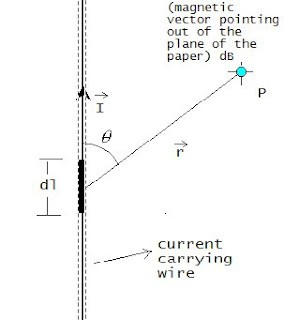The vector cross product is an operation on two vectors which yields a third vector in a direction which is perpendicular to the plane containing the two input vectors.
Strictly mathematically speaking, the cross product is a binary operation there by involving two operands, an operation and a single output.
The cross product, A x B, gives a third vector, say C in a direction perpendicular to the plane containing the two input vectors. A famous example of such a vector cross product is the Biot-Savart Law.
The Biot-Savart Law relates the strength of a magnetic field, dB produced due to the current flowing in a length of wire dl, at any distance r from the wire.
® ®
dB = [μ0/(4*p*r3)]*(I X r)
So, there are two inputs: a current vector and a distance vector that have to be specified. Then, the cross product operation will produce the output, i.e. a magnetic vector that results from that combination.
Note that since the magnetic force is the product of the two inputs (namely current and displacement unit vector) it will figure on
the left side of the equation and the inputs on the right side of the Biot-Savart equation.
Fine!!
Now let us look at the basic operation of a gyroscope. Take a look at the diagram below showing the two inputs (the black arrowheads) and the output (the blue arrow head).
Given that we need two simultaneous inputs - a spinning wheel and a torque upon its axis- to produce the output i.e. precession AND given that a cross product is involved, we might be forgiven for guessing that analogous to Biot-Savart's Law above the formula would read
w = t X L
However we would be wrong. As the correct formula reads:
t = w X L
hhmmm..
well, I thought we APPLIED the torque to RECEIVE the precessive velocity?
The actual formula however seems to be implying that the precessive velocity is an input just as much as the spinning wheel's angular momentum is. The two act upon each other, producing torque.
This is a reversal of cause and efect.
How to understand this? There is no conventional explanation for this reversal. It is merely illustrated without explanation in books. Some attempt vectorial gymnastics in an attempt to show that all is in aacordance with "physics", but none have acknowledged this weirdness and offered an explanation. The simple explanation for this reversal lies in the underlying relativistic analogy between electricity and spinning wheels.
The most useful mnemonic in ElectroMagnetism is probably 'ELI the ICE man'. (The following is excerpted from Resnick & Halliday, Fundamentals of Physics)
ELI contains the letter L (for inductor), and in it the letter I (for current) comes after the letter E (for emf or voltage). Thus, for an inductor, the current lags the voltage. Similarly ICE (which contains a C for capacitor) means that the current leads the voltage. You might also use the modified mnemonic "ELI positively is the ICE man" to remember that the phase constant f is positive for an inductor. End Excerpt
The way to translate "leads" in electricity to the mechanical version is to substitute "appears to be the cause of" in its place.
Note that according to the mnemonic, we can see that Current Leads Voltage in capacitive conditions - that is in our mechanical analogue, we would say Force Leads Angular Velocity or Force appears to be the cause of Angular velocity (via acceleration) and since almost all interactions we see in daily life are capacitive, we have viscerally absorbed the idea that force causes a change in velocity.
Voltage Leads Current in an inductor - so in the Mechanical analogy for a spinning wheel, Precessive Velocity Leads the Applied Torque i.e. Precessive Velocity appears to be the cause of the Applied Torque. Thus inductive behavior is characterized by this kind of a reversal of cause and effect.
While in electricity (due to the wonderful conformation of Maxwell's Laws with the Lorentz Transformations and therefore Relativity), this behavior results in another area of study (ElectroMagnetic oscillations and RLC circuits) and another mnemonic for the student to remember, in mechanics it has been ignored up until now. We are discovering here that in the inductive condition, the precessive velocity appears to be the cause of the force i.e. a gyroscope is an inductive element, unlike non-spinning objects, which are capacitive elements.
Our daily experience with the physical world involves only capactive encounters. There for we have a very hard time 'instinctively' grasping the differences in the behavior. They can appear are riddles at time. Gyroscopic behavior is a perfect example. The analogies between ElectroMagnetism and mechanics & gravitation are deep and the path lies through Kron's Generalized Machine Theory.
The gyroscopic formula is merely reflecting that fact.


No comments :
Post a Comment